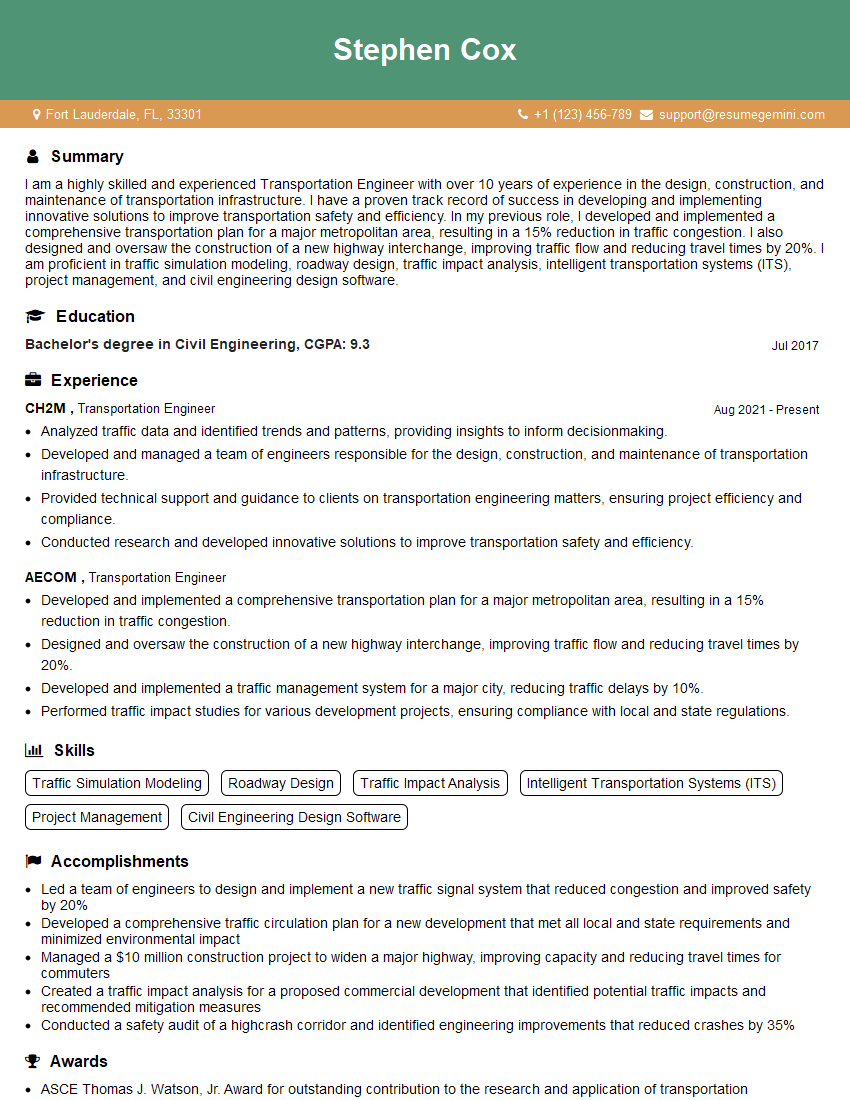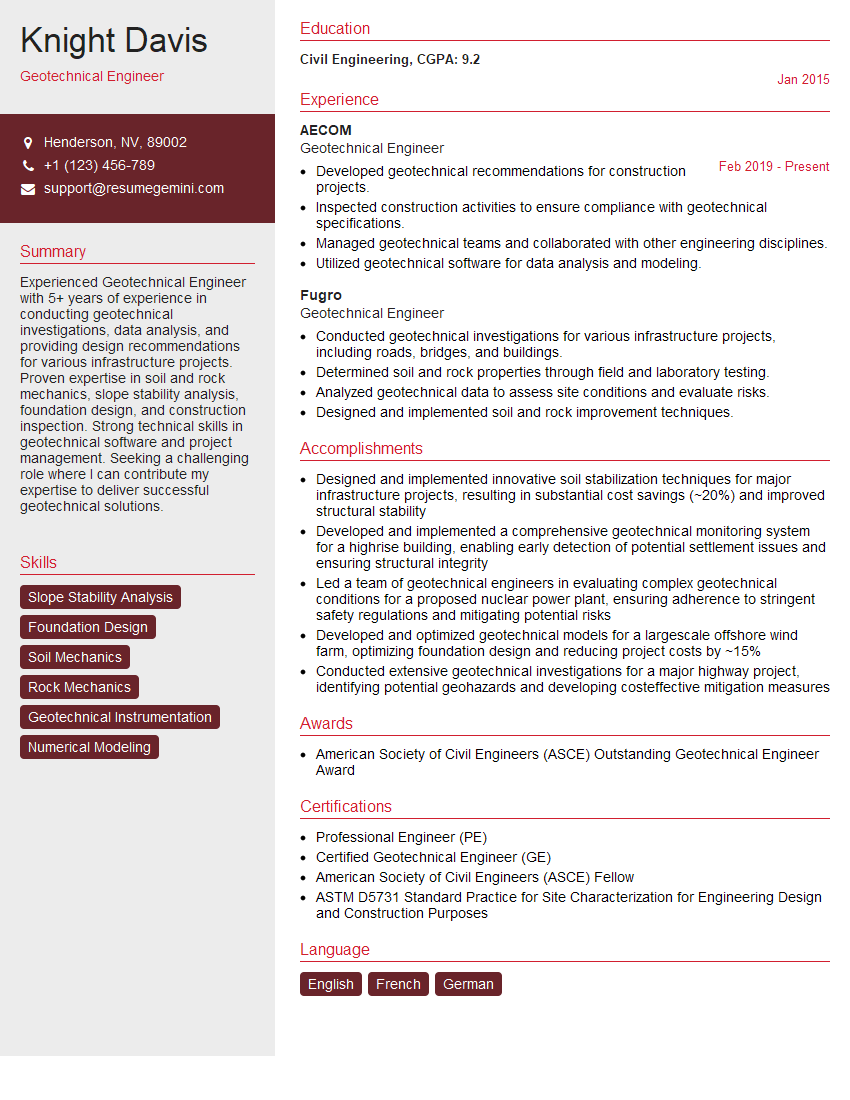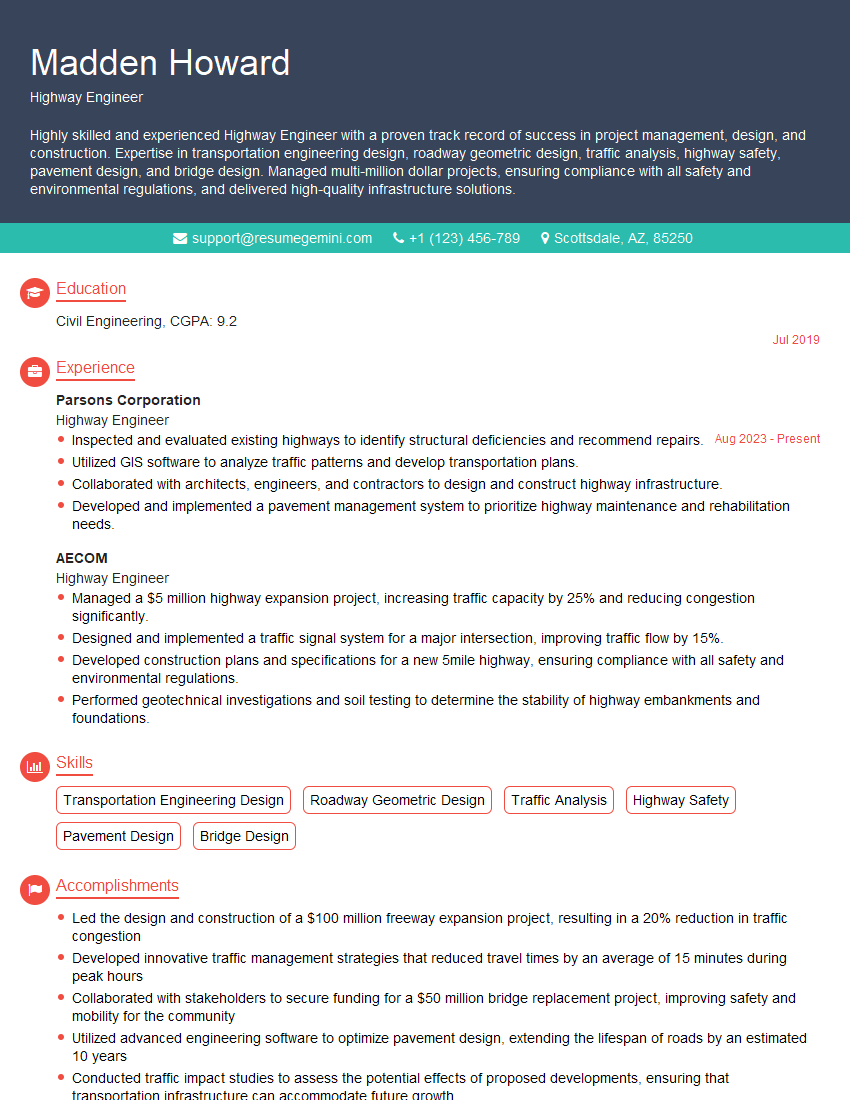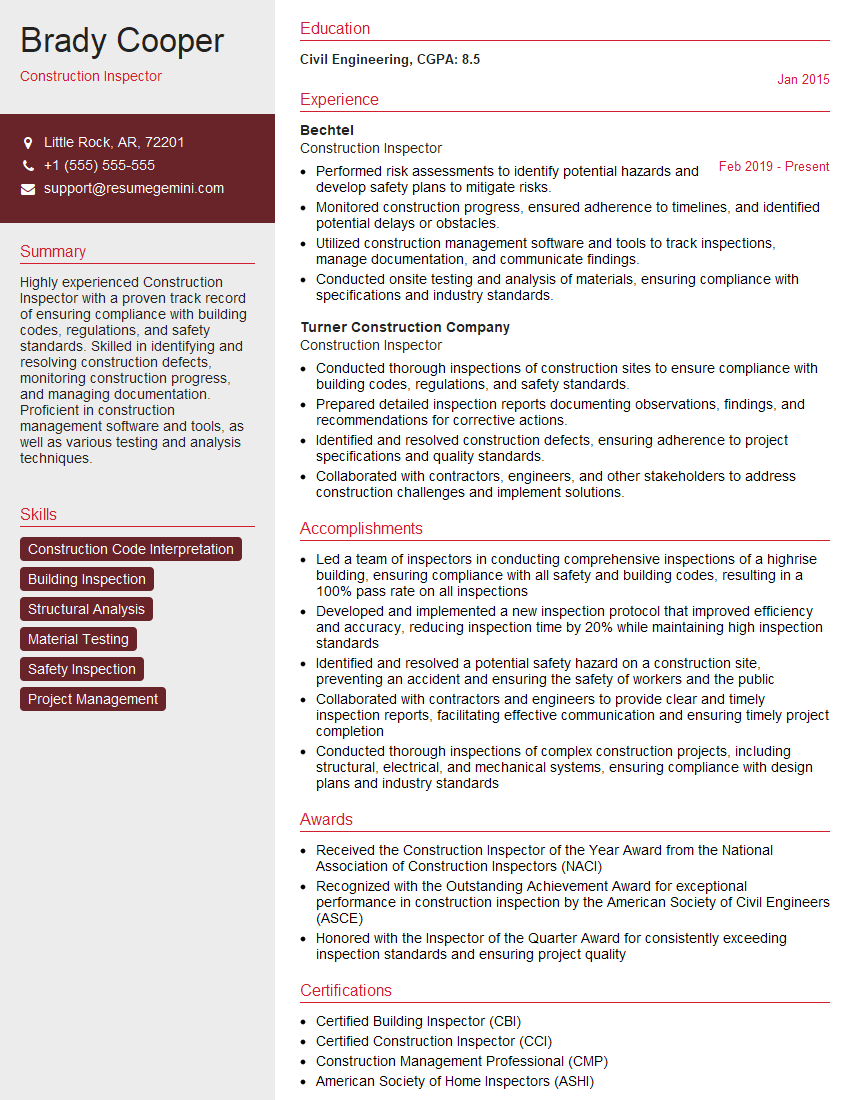Cracking a skill-specific interview, like one for Asphalt Emulsion, requires understanding the nuances of the role. In this blog, we present the questions you’re most likely to encounter, along with insights into how to answer them effectively. Let’s ensure you’re ready to make a strong impression.
Questions Asked in Asphalt Emulsion Interview
Q 1. Explain the different types of asphalt emulsions and their respective uses.
Asphalt emulsions are categorized based on their binder type (cationic or anionic) and their breaking mechanism (rapid-setting, medium-setting, slow-setting). This classification dictates their application.
- Cationic Emulsions: These are positively charged and are ideal for aggregate surfaces with a high silica content, like limestone. They exhibit strong adhesion and are commonly used in surface treatments, seal coats, and crack sealing on roads with good drainage. Think of it like a magnet – the positive charge strongly attracts the negatively charged aggregate.
- Anionic Emulsions: Negatively charged, these work best on aggregates with low silica content or those already coated with asphalt. They are often preferred for applications requiring flexibility and durability, such as base courses and pavement overlays. The negative charge is more likely to be repelled by similar negative charges, making them better suited for certain aggregate types.
- Rapid-Setting Emulsions: These break quickly, ideal for applications where fast setting is critical, such as tack coats to ensure adhesion between layers of asphalt. Think of them as a quick-drying glue.
- Medium-Setting Emulsions: Offer a balance between rapid and slow setting, providing flexibility in application and allowing for better workability. They’re often chosen for mix-in-place applications.
- Slow-Setting Emulsions: Provide excellent workability and are used in applications requiring longer setting times, such as slurry seals or surface treatments where extended time for compaction is needed. These act more like a slow-setting cement.
The choice depends greatly on the project’s requirements, the type of aggregate used, and the desired pavement performance.
Q 2. Describe the process of asphalt emulsion production.
Asphalt emulsion production involves several key steps: first, asphalt cement is heated to a specific temperature to reduce its viscosity. Then, this heated asphalt is emulsified by blending it with water containing an emulsifying agent. This agent is a surfactant that reduces the surface tension between the asphalt and water, allowing them to form a stable emulsion. Think of a milkshake – the emulsifier prevents the oil and water from separating.
The process is typically carried out in a colloid mill, where high-shear forces break down the asphalt into tiny droplets that are evenly dispersed in the water. The resulting emulsion is then cooled and stored in tanks before distribution. The type of emulsifier, water-to-asphalt ratio, and mixing intensity all influence the emulsion’s properties, like viscosity and setting time.
Quality control during production is paramount. Regular testing ensures the emulsion meets the required specifications, including particle size distribution and viscosity.
Q 3. What are the key properties of asphalt emulsions that influence their performance?
Several key properties of asphalt emulsions govern their performance. These properties influence both application and long-term pavement behavior.
- Viscosity: The resistance to flow. This influences the ease of application and the ability to achieve proper compaction. Too viscous, and it’s hard to spray; too low, and it might run off.
- Setting Time: The time it takes for the emulsion to break and the asphalt to coalesce. Too fast, and you’ll have difficulty with application; too slow, and it might be vulnerable to early traffic.
- Particle Size Distribution: The size and distribution of the asphalt droplets influence stability and long-term performance. A well-distributed size ensures the emulsion remains stable and mixes well.
- Breaking Time/Mechanism: How quickly the emulsion breaks (separates into asphalt and water) is critical for achieving proper bonding and strength.
- Storage Stability: The emulsion’s ability to retain its properties over time. If it separates during storage, it’s useless.
These properties are interconnected, with changes in one potentially affecting the others. Balancing these properties is essential for producing and selecting the right emulsion for a specific application.
Q 4. How do you determine the optimal emulsion type for a specific project?
Choosing the optimal emulsion requires a detailed understanding of the project’s specifics. It’s not a one-size-fits-all situation.
- Project Requirements: What type of application is it? (e.g., seal coat, tack coat, slurry seal)
- Climate Conditions: Temperature and humidity influence setting time and curing.
- Aggregate Type: The type of aggregate impacts the choice between cationic and anionic emulsions. The aggregate’s gradation (size distribution) also matters.
- Traffic Levels: High traffic volume demands durable and fast-setting emulsions.
- Budgetary Constraints: Different emulsions have varying costs.
After considering these factors, laboratory testing using representative aggregates can provide valuable data to help make an informed selection. This often involves trial mixes and evaluating the resultant properties.
Q 5. Explain the importance of viscosity in asphalt emulsion selection.
Viscosity is a crucial factor in asphalt emulsion selection because it directly impacts the ease of application and the quality of the final pavement. Imagine trying to spread honey versus water – the honey, being more viscous, would be more challenging.
Low viscosity emulsions are easier to spray and spread, covering a larger area, but might have challenges in achieving sufficient compaction. High viscosity emulsions are better for applications requiring greater control and potentially thicker layers, but may be difficult to pump and spray uniformly. The ideal viscosity is project-specific and depends on the application method and equipment used.
Selecting an emulsion with the appropriate viscosity ensures that the asphalt is properly distributed, achieving optimal adhesion and compaction, and leading to a durable and long-lasting pavement.
Q 6. What are the common testing methods used to evaluate asphalt emulsion properties?
Several tests evaluate asphalt emulsion properties. These are typically performed according to standard procedures (e.g., AASHTO standards). Common tests include:
- Viscosity: Measured using viscometers (e.g., Saybolt Furol viscometer) at specified temperatures.
- Sieve Analysis: Determines the particle size distribution.
- Breaking Time: Measures the time it takes for the emulsion to break (separate into asphalt and water). This is often done using a demulsification test.
- Storage Stability: Assessed by observing separation or sedimentation after a period of storage.
- Adhesion: Evaluated using pull-off tests or other methods that assess the bond strength between the emulsion and aggregates.
- Cohesion: Measures the internal strength of the emulsion film.
The specific tests used depend on the intended application and the required quality control measures.
Q 7. Describe the factors influencing the setting time of asphalt emulsion.
The setting time of an asphalt emulsion is influenced by several factors.
- Emulsion Type: Rapid-setting emulsions break quickly, while slow-setting emulsions take longer. This is largely controlled by the emulsifier used and its concentration.
- Temperature: Higher temperatures typically accelerate the breaking process.
- Humidity: High humidity can slow down the breaking process, as water inhibits the coalescence of asphalt droplets.
- Aggregate Type: The chemical composition of the aggregate influences the rate of emulsion breaking.
- pH: The pH of the emulsion and the aggregate also affects the interaction and thus the setting time.
Understanding these factors is crucial for proper application and ensuring the desired pavement performance. For instance, in hot climates, you might choose a slower-setting emulsion to avoid premature setting and difficulties in compaction.
Q 8. How do you ensure the quality control of asphalt emulsion during and after production?
Ensuring the quality of asphalt emulsion is paramount for project success. Our quality control (QC) process is rigorous and encompasses both in-process and post-production checks. During production, we continuously monitor key parameters like viscosity, emulsion stability (using techniques like centrifugal testing), and binder content. Automated systems alert us to any deviations from pre-set specifications, allowing for immediate corrective actions. Post-production, we conduct comprehensive testing on samples from each batch. This includes determining the breaking time, storage stability, and setting time, often using standardized procedures like those outlined in AASHTO specifications. We meticulously document all test results, ensuring traceability and accountability. Any batch failing to meet the required standards is rejected and either reprocessed or discarded, depending on the nature of the defect. Think of it like baking a cake – you wouldn’t serve a cake that hasn’t risen properly or is undercooked. Similarly, substandard emulsion leads to poor pavement performance.
Q 9. Explain the impact of temperature on asphalt emulsion performance.
Temperature significantly impacts asphalt emulsion performance. Higher temperatures can accelerate breaking (the process where the asphalt binder separates from the water), potentially leading to premature setting. This can hinder workability and negatively affect the final pavement quality. Imagine trying to spread honey that’s too warm – it’s difficult to control. Conversely, low temperatures can thicken the emulsion, making it harder to pump and apply evenly. This can create inconsistencies in the pavement layer, affecting its durability and performance. We account for these temperature sensitivities through careful planning and execution, considering factors like ambient temperature, storage conditions, and the specific emulsion type being used. Adjustments in the application methods, like preheating the emulsion on colder days, are common practices to maintain optimal performance.
Q 10. What are the environmental considerations related to asphalt emulsion use?
Environmental considerations are crucial in asphalt emulsion applications. The manufacturing process itself can generate some volatile organic compounds (VOCs), though modern production methods have significantly reduced these emissions. We minimize environmental impact by implementing robust air pollution control systems and employing best practices in waste management. During application, we strive to minimize spills and runoff, preventing contamination of water bodies. The use of asphalt emulsion, compared to hot asphalt, also reduces greenhouse gas emissions due to lower temperatures required for application. It is also increasingly common to utilize recycled materials, such as reclaimed asphalt pavement (RAP), in the production of emulsions, further contributing to sustainability. We always comply with all relevant environmental regulations and strive to continuously improve our environmental footprint.
Q 11. How do you handle asphalt emulsion spills and waste?
Handling spills and waste is an essential aspect of responsible asphalt emulsion management. In case of a spill, we immediately implement a containment strategy, preventing further spread. This usually involves using absorbent materials like sand or specialized spill kits to absorb the emulsion. The contaminated material is then disposed of according to local regulations, often through specialized waste contractors. Waste emulsion is typically handled similarly, following strict guidelines to ensure proper disposal. We conduct regular training for our staff to ensure they are aware of spill response procedures and proper waste handling techniques. We also maintain a comprehensive emergency response plan to address unforeseen incidents promptly and effectively.
Q 12. Describe the role of emulsion breakers in asphalt emulsion applications.
Emulsion breakers are crucial in controlling the setting time of asphalt emulsion. They are chemicals added to accelerate the separation of the asphalt binder from the water phase. The choice of emulsion breaker depends on the type of emulsion and the desired setting time. For instance, cationic emulsions typically use anionic breakers, while anionic emulsions might employ cationic breakers. The breaker’s role is to destabilize the emulsion, allowing the asphalt particles to coalesce and form a continuous film. This is analogous to breaking an egg yolk – the breaker disrupts the emulsifying agent, leading to separation. The careful selection and dosage of emulsion breakers are crucial for achieving the desired performance in the final pavement layer, ensuring proper adhesion and setting time.
Q 13. What are the advantages and disadvantages of using asphalt emulsion compared to other binding agents?
Asphalt emulsion offers several advantages over traditional hot asphalt mixes. It’s easier to handle and apply, requiring lower temperatures, which reduces energy consumption and environmental impact. Its lower application temperature also reduces the risk of worker injuries. It is more suitable for various applications, including tack coats, seal coats, and microsurfacing. However, asphalt emulsions can be sensitive to temperature fluctuations and may require specialized application equipment. Furthermore, the setting time needs to be carefully managed. Compared to other binding agents like cement, asphalt emulsion offers superior flexibility and waterproofing properties, particularly in road construction, making it a preferred option for many projects.
Q 14. How does the aggregate type influence the selection of asphalt emulsion?
The type of aggregate significantly influences the selection of asphalt emulsion. The aggregate’s properties, such as surface area, texture, and mineralogy, affect the adhesion of the emulsion. For instance, a highly porous aggregate might require an emulsion with better penetration capabilities to ensure proper binding. Conversely, a smooth, dense aggregate might necessitate an emulsion with a higher viscosity to maintain stability. We carefully analyze the aggregate properties during project planning to select the appropriate emulsion type that ensures optimal bond strength and pavement performance. The selection process also considers factors like the climate and the intended application, allowing us to tailor the emulsion to the specific needs of the project.
Q 15. Explain the importance of proper mixing and application techniques for asphalt emulsion.
Proper mixing and application techniques are crucial for achieving the desired performance and longevity of asphalt emulsion pavements. Think of it like baking a cake – if you don’t mix the ingredients correctly or bake it at the wrong temperature, you won’t get a good result. With asphalt emulsion, improper mixing can lead to inconsistencies in the emulsion’s properties, while incorrect application can result in poor adhesion, stripping, and premature failure.
- Mixing: Asphalt emulsion needs to be thoroughly mixed before and during application to ensure a uniform distribution of binder and aggregate. This prevents sedimentation, where the heavier components settle to the bottom, leading to an uneven surface. Specialized mixing equipment is often used, ensuring consistent blending of the emulsion. Insufficient mixing can lead to a weak and uneven pavement structure.
- Application: The application method depends on the type of emulsion and the project requirements. Factors such as temperature, aggregate gradation, and application rate must be carefully controlled. Spraying techniques, for example, need to ensure even distribution and penetration. Applying too much or too little emulsion can compromise the pavement’s performance. Proper compaction is also essential to achieve the desired density and strength.
For instance, using the wrong spray nozzle pressure could result in an uneven application, leading to areas with insufficient binder and others with excess. Similarly, inadequate compaction after application can leave the pavement vulnerable to rutting and cracking.
Career Expert Tips:
- Ace those interviews! Prepare effectively by reviewing the Top 50 Most Common Interview Questions on ResumeGemini.
- Navigate your job search with confidence! Explore a wide range of Career Tips on ResumeGemini. Learn about common challenges and recommendations to overcome them.
- Craft the perfect resume! Master the Art of Resume Writing with ResumeGemini’s guide. Showcase your unique qualifications and achievements effectively.
- Don’t miss out on holiday savings! Build your dream resume with ResumeGemini’s ATS optimized templates.
Q 16. What are the common problems encountered during the application of asphalt emulsion?
Several problems can arise during asphalt emulsion application. These are often related to improper handling, inadequate site conditions, or equipment malfunction. Common issues include:
- Stripping: Separation of the asphalt binder from the aggregate, resulting in a weak pavement structure. This is often caused by the presence of excessive moisture or incompatible aggregate.
- Bleeding: Excess asphalt binder appearing on the surface of the pavement, leading to a sticky, unstable surface. This usually occurs due to an excessive amount of asphalt emulsion or inadequate compaction.
- Poor adhesion: Inadequate bond between the emulsion and the underlying surface, resulting in poor pavement performance and potential cracking. This is often due to a dirty or contaminated surface or incorrect emulsion selection.
- Uneven distribution: Inconsistent application of the emulsion, resulting in areas with insufficient binder, leading to weakness, and areas with excess, leading to bleeding. This commonly stems from equipment malfunctions or inappropriate application techniques.
- Early setting/loss of workability: Asphalt emulsion can lose workability too quickly due to rapid evaporation of water, improper mixing, or using an incompatible emulsion type. This complicates proper compaction and leads to a compromised pavement quality.
Imagine applying paint to a dirty wall – the adhesion won’t be good. The same applies to asphalt emulsion; a clean, dry surface is critical for successful adhesion.
Q 17. How do you troubleshoot issues related to emulsion stripping or bleeding?
Troubleshooting emulsion stripping and bleeding requires a systematic approach. It’s crucial to identify the root cause before implementing solutions.
- Stripping: If stripping occurs, investigate the aggregate’s properties (absorption, fines content, and chemical composition). Moisture content in the aggregate or the underlying layer is another crucial factor. In such cases, consider using an anti-stripping additive or choosing a more compatible emulsion type. Improved compaction techniques can sometimes improve this.
- Bleeding: Bleeding is typically addressed by reducing the application rate of the emulsion, using a lower viscosity emulsion, or improving compaction. Ensuring proper aggregate gradation, which prevents excess emulsion from rising to the surface, can also resolve this issue. In extreme cases, removing the affected surface and reapplying the emulsion with improved techniques might be required.
A thorough analysis, possibly including laboratory testing of the aggregate and emulsion, is often necessary to pinpoint the cause of these problems. This could involve determining the moisture content of the base material, testing the aggregate for reactive fines, or evaluating the emulsion’s properties, such as its viscosity and breaking characteristics.
Q 18. Describe the methods used to evaluate the durability of asphalt emulsion pavement.
Evaluating the durability of asphalt emulsion pavements involves a combination of laboratory testing and field performance monitoring. The goal is to assess the pavement’s resistance to various forms of distress, including cracking, rutting, and stripping.
- Laboratory Testing: This may include evaluating the emulsion properties (viscosity, breaking time, storage stability), aggregate characteristics (gradation, strength, absorption), and the performance of the mix design (stability, flow). Testing can assess the resistance of the pavement to water damage, freezing-thaw cycles, and other environmental factors.
- Field Performance Monitoring: This involves visual inspections, measurements of pavement surface conditions (rutting, cracking), and performance evaluations over time. Data collection is crucial, enabling the comparison of pavement performance across different projects and emulsion types.
- Non-destructive Testing (NDT): Techniques like Falling Weight Deflectometer (FWD) testing can measure the pavement’s structural capacity and stiffness, providing insight into its long-term durability.
Consider this like monitoring a patient’s health – regular checkups and tests reveal potential problems early, allowing for timely interventions to prevent serious complications.
Q 19. Explain the significance of adhesion in asphalt emulsion applications.
Adhesion is paramount in asphalt emulsion applications. It refers to the ability of the emulsion to bond effectively with the aggregate and the underlying pavement layers. Poor adhesion leads to pavement failure in various ways. Imagine trying to glue two pieces of wood together with weak glue; the joint will fail. The same principle applies to asphalt emulsion.
Strong adhesion is necessary to transfer loads effectively, preventing cracking and rutting. It also helps ensure the stability of the pavement structure, preventing the separation of the asphalt binder from the aggregate (stripping). The surface condition, the type of emulsion used, the moisture content of the aggregate, and proper compaction all influence adhesion. Selecting the correct emulsion type for the specific aggregate and environmental conditions is vital for achieving good adhesion.
Q 20. How does the storage and handling of asphalt emulsion affect its properties?
Improper storage and handling of asphalt emulsion can significantly affect its properties and performance. Asphalt emulsion is a sensitive material; its quality degrades over time, particularly if it’s not handled and stored correctly.
- Temperature: Extreme temperatures can accelerate the emulsion’s breaking process and alter its viscosity. Exposure to freezing temperatures can cause separation and damage the emulsion irreparably. Elevated temperatures can lead to premature setting and loss of workability.
- Storage: Asphalt emulsion should be stored in a cool, dry location, protected from direct sunlight and extreme temperature fluctuations. The storage tanks should be clean and adequately sealed to prevent contamination.
- Agitation: Regular agitation is often necessary during storage to prevent sedimentation and maintain a uniform consistency. However, excessive agitation can break the emulsion prematurely.
- Shelf Life: Emulsions have a limited shelf life. Using aged emulsions can greatly impact the pavement quality, leading to reduced performance.
Think of it like milk; it spoils if not stored correctly. Similarly, asphalt emulsion’s quality deteriorates if subjected to inappropriate conditions.
Q 21. What are the current industry standards and specifications for asphalt emulsion?
Industry standards and specifications for asphalt emulsion vary by region and governing body but are generally based on performance requirements and testing procedures outlined in documents such as those produced by AASHTO (American Association of State Highway and Transportation Officials) and ASTM International. These specifications cover various aspects including:
- Emulsion type: Specifications define different emulsion types based on their binder content, viscosity, breaking characteristics, and intended use (e.g., surface treatment, prime coats, seal coats).
- Testing methods: These standards outline detailed procedures for testing the emulsion’s properties, including viscosity, breaking time, and storage stability.
- Performance requirements: Specifications set performance criteria for the finished pavement, such as resistance to stripping, rutting, and cracking. These ensure the emulsion meets quality standards to produce a durable, high-performing road.
- Quality control: Specifications often include provisions for quality control measures to ensure that the emulsion meets the specified requirements throughout its production and use. Regular inspections and testing are crucial.
Adherence to these standards is critical to ensuring consistent quality and performance of asphalt emulsion pavements. These standards ensure interoperability, enabling projects to be completed reliably and efficiently, regardless of the supplier.
Q 22. Describe your experience with different types of asphalt emulsion equipment.
My experience encompasses a wide range of asphalt emulsion equipment, from small-scale laboratory mixers used for experimental purposes to large-capacity production plants. I’m familiar with both batch and continuous mixing processes. In the lab, I’ve worked extensively with colloid mills and high-shear mixers to control the particle size distribution of the emulsion. On larger scales, I have experience with emulsion plants utilizing different types of pumps, storage tanks, and aging tanks, all crucial for ensuring consistent product quality. Specifically, I’ve worked with equipment from manufacturers like [Mention specific manufacturers if comfortable, otherwise omit]. Troubleshooting equipment malfunctions, particularly pump issues and maintaining optimal mixing parameters for different emulsion types, has been a significant part of my role. For example, I once diagnosed a recurring clog in a colloid mill by analyzing the aggregate size distribution in the feedstock and adjusting the mill’s operating parameters. This highlighted the importance of precise control over all aspects of the production process.
Q 23. Explain your understanding of different asphalt emulsion specifications (e.g., AASHTO, etc.)
Asphalt emulsion specifications, like those from AASHTO (American Association of State Highway and Transportation Officials), are critical for ensuring quality and performance. These specifications define various properties, including viscosity, breaking time, storage stability, and even the type and amount of emulsifier used. For example, AASHTO M 140 covers various types of slow-setting asphalt emulsions. Understanding these specifications allows us to tailor emulsion properties for specific applications. A slow-setting emulsion, like those specified in AASHTO M 140, might be ideal for surface treatments, whereas a rapid-setting emulsion might be better suited for seal coats. The specifications also dictate testing methods, ensuring that all manufacturers and users operate under the same standards. The numeric designations within the AASHTO standards (e.g., M 200) are crucial for project specifications and procurement. Deviations from these standards require careful consideration and justification.
Q 24. How do you interpret the results of asphalt emulsion testing?
Interpreting asphalt emulsion test results requires a thorough understanding of the different tests and their significance. For instance, viscosity measurements indicate the emulsion’s flow characteristics, crucial for application equipment selection. Breaking time tests determine how quickly the asphalt binder separates from the water, impacting the setting time and effectiveness of the emulsion. Storage stability assessments are crucial for ensuring that the emulsion remains homogenous over time. I regularly use these parameters to diagnose any potential issues during production or application. For example, a higher-than-expected viscosity might indicate improper mixing or the presence of excess aggregate, requiring adjustments to the production process or raw materials. Similarly, a shorter breaking time could point towards a problem with the emulsifier or the water quality, necessitating investigations and corrective actions. By comparing test results against the relevant specifications, we can determine if an emulsion batch meets quality standards.
Q 25. Describe your experience in using software for asphalt emulsion design or analysis.
I have experience with several software packages used for asphalt emulsion design and analysis. These tools allow for the precise calculation of emulsion formulations and performance prediction. While specific software names are proprietary to my previous employers, I am comfortable working with programs that allow for the modeling of emulsion behavior under different conditions. This includes simulating the effects of temperature, aggregate type, and emulsifier chemistry on the final product’s properties. Furthermore, I can use data analysis software to process and interpret the large amounts of data generated from emulsion testing, which greatly enhances efficiency and provides valuable insights into process optimization and quality control. One project involved using specialized software to simulate the long-term performance of different emulsion types under various climate conditions to aid in selecting the optimal emulsion for a specific highway project.
Q 26. How do you ensure the compatibility of asphalt emulsion with different types of aggregates?
Ensuring compatibility between asphalt emulsion and aggregates is critical for the long-term performance of pavement. Incompatibility can lead to stripping, where the binder separates from the aggregate, resulting in premature pavement failure. I address this through a combination of techniques. This includes selecting aggregates with appropriate surface characteristics and conducting laboratory tests to assess compatibility. For example, we might use the modified Hamburg wheel-tracking test to evaluate the stripping potential. I consider factors like the aggregate’s texture, absorption capacity, and surface chemistry. The chemical properties of the emulsion itself, especially the emulsifier type, also greatly affect compatibility. Sometimes, adjustments to the emulsion formulation or the use of additives might be necessary to ensure optimal compatibility with specific aggregates. For instance, if a particular aggregate exhibits high absorption, a modified emulsion with a higher viscosity might be used to counteract this behavior.
Q 27. What are the safety precautions that should be taken when handling asphalt emulsion?
Safety is paramount when handling asphalt emulsion. It’s crucial to follow established safety protocols, including wearing appropriate personal protective equipment (PPE), such as gloves, eye protection, and respiratory protection, as asphalt emulsion can irritate skin and eyes. Proper ventilation is also crucial in handling areas to minimize exposure to fumes and vapors. We must also be mindful of fire hazards, as asphalt emulsion is flammable. Spill response plans and appropriate containment procedures should be in place. Proper training for all personnel involved is essential, emphasizing safe handling, storage, and disposal procedures. We should also adhere to all relevant OSHA regulations and local safety guidelines to ensure worker safety and environmental protection. Following these precautions minimizes the risk of accidents and promotes a safe working environment.
Q 28. Describe your experience working with different stakeholders on asphalt emulsion projects.
My experience working with stakeholders on asphalt emulsion projects has been extensive and rewarding. I’ve successfully collaborated with engineers, contractors, material suppliers, and regulatory agencies. Effective communication is key; I ensure that technical information is presented in a clear and concise manner, avoiding technical jargon whenever possible. For example, when communicating with contractors, I focus on the practical aspects of emulsion application and performance, rather than delving into complex chemical details. With engineers, a more technical approach is adopted, discussing design parameters and testing data. Collaboration with suppliers helps ensure we obtain high-quality materials. By engaging stakeholders early and often and building consensus around key decisions, we improve project outcomes and ensure project success. I’ve found that proactively addressing potential issues and facilitating open communication consistently results in smoother project execution and collaborative problem-solving.
Key Topics to Learn for Asphalt Emulsion Interview
- Types of Asphalt Emulsions: Understand the different types (cationic, anionic, etc.), their properties, and their suitability for various applications.
- Emulsion Properties and Testing: Familiarize yourself with viscosity, breaking characteristics, storage stability, and common testing methods used to assess emulsion quality.
- Application Methods and Equipment: Learn about different application techniques (spraying, fog sealing, etc.) and the equipment used in each process. Consider the impact of environmental conditions on application.
- Performance and Durability: Explore factors influencing the long-term performance of asphalt emulsion pavements, such as environmental factors, traffic loads, and aggregate properties.
- Mix Design and Optimization: Understand the principles of designing asphalt emulsion mixes, considering factors such as aggregate gradation, emulsion type, and binder content.
- Quality Control and Assurance: Familiarize yourself with quality control procedures throughout the production, application, and lifecycle of asphalt emulsion projects.
- Environmental Considerations: Understand the environmental impact of asphalt emulsion use and the measures taken to minimize its effect (e.g., VOC emissions).
- Troubleshooting and Problem Solving: Be prepared to discuss common problems encountered during asphalt emulsion application and propose solutions based on your understanding of the material and process.
- Health and Safety: Understand the relevant safety precautions and regulations associated with handling and applying asphalt emulsions.
Next Steps
Mastering asphalt emulsion knowledge opens doors to exciting career opportunities in the construction and infrastructure sectors. A strong understanding of this material is highly valued by employers seeking skilled professionals. To enhance your job prospects, creating a well-crafted, ATS-friendly resume is crucial. ResumeGemini is a trusted resource that can help you build a professional resume that highlights your skills and experience effectively. Examples of resumes tailored to the Asphalt Emulsion industry are available through ResumeGemini to guide you in crafting your own compelling application.
Explore more articles
Users Rating of Our Blogs
Share Your Experience
We value your feedback! Please rate our content and share your thoughts (optional).
What Readers Say About Our Blog
Live Rent Free!
https://bit.ly/LiveRentFREE
Interesting Article, I liked the depth of knowledge you’ve shared.
Helpful, thanks for sharing.
Hi, I represent a social media marketing agency and liked your blog
Hi, I represent an SEO company that specialises in getting you AI citations and higher rankings on Google. I’d like to offer you a 100% free SEO audit for your website. Would you be interested?







